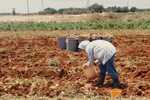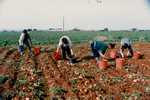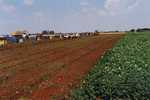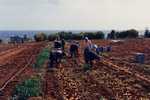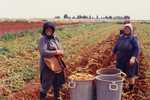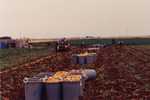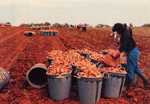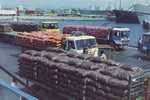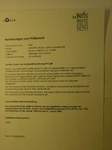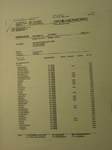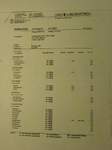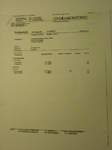CYPRUS
POTATOES (information February 2005 from C.P.M.B. - Cyprus Potatoe
Marketing Board)
Although in Cyprus, due to the mild climate and topography,
fresh potatoes are harvested nearly all year around,
for practical, historical and statistical reasons, the Cyprus
potato production is divided in 4 crops namely: The WINTER
CROP, which planted in August/September and harvested in
November until February. This crop consists of 50% of the local
consumption market and 50% of the export market. The SPRING
CROP or the 'Main crop' which is planted in November/February
and harvested in March/June (mainly for export but also for
local consumption). The INTERMEDIATE CROP planted in
October and harvested in late February, beginning of March (a
small crop mainly produced for export). The SUMMER CROP
planted in April/June on Troodos mountains (very small quantities
mainly for the local market). It must be stressed that all potatoes
for export (except in special occasions) comply with the Geneva
definition of New Potatoes because they are lifted fresh, marketed
fresh and are "scrapers".
About
80-85% of Cyprus potatoes are produced in the coastal red
soil area, South-East of Cyprus between the occupied by the
Turkish troops "Ghost Town" Famagusta and the town
of Larnaca. Around 70% of the total production is exported,
mainly to European countries. Main Exporting Markets for Cyprus
Potatoes are the UK, Germany and Belgium. Considerable quantities
are also exported to Norway, Sweden, Denmark, Holland, Ireland,
Austria, Switzerland, Croatia, Greece, Italy and small quantities
to many other countries. Last year, the Cyprus potato production
was approximately 130,000 tons, consisting of 85,000 on exports
by the C.P.M.B. and only 2-3 thousand tons by other exporters
(after the 1st of May). The UK imported a quantity of 16000
tons mainly for the wholesale markets. The balance (some 40-42
thousand tons have been consumed in Cyprus).
The
Cyprus Potato Marketing Board, established by Law in 1964,
secured for more than 40 years a fair share of the world market
price for the Cypriot growers. The role of the C.P.M.B
however, is changing since Cyprus joined the EU the 1st of
May 2004.
The
growers cannot anymore get any direct subsidies from the
Cyprus State and of course not from the E.U as no common
regime exist for potatoes. The C.P.M.B. lost the monopolising
power as well as the central potato planning for the whole
Cypriot potato industry. However the CPMB still retains
most of its role in Cyprus potato industry. Most of
the growers are now organised in "Growers Groups".
The largest group is the Pancyprian Organisation of Potato
Growers (P.O.P) with 768 growers (from the approximate
1500 potato growers) cooperating with C.P.M.B. (which cooperates
also with some individual growers). The CPMB is doing the
planning (quantities, varieties, etc) the packing the shipping,
the marketing etc.
For
the 2004/2005 season C.P.M.B exports are planned to
reach 50000 tons of potatoes (5-7 thousand tons winter all
around 45000 tons spring potatoes). Up to now (end of February)
some 4500 tons winter crop potatoes have been exported by
the Board to 17 European countries. C.P.M.B. / P.O.P. growers
will grow several varieties for the next season the
main one being the following :
a)
"Normal" table potatoes (rather firm cooking
varieties): Spunta (cooking type B), Marfona (B-C),
Timate (B), Marabel (B).
b)
"Salad" potatoes (firm cooking): Nicola
(A-B), Charlotte (A-B), Ditta (A-B), Inova
(A-B), Filea (A-B), Princess (A), Sieglinde
(A-B) Bernadette (A-B).
c)
"Flowering" firm cooking potatoes: Cara
(C-B), Diamant (C-B).
Potatoes
for export will be packed according to the clients preferences
in polypropylene bags (15,20,25 Kg) in jumbos (1000 and 1250
Kg) and boxes of 500 Kg ( directly from the fields, and
grated in various sizes (25-35/38mm, 35-45mm, 35-55mm,
45+mm, 65+mm, mixed sizes, etc).
All
chemical treatments during growth are carried out according
to E.U. regulations; no chemical is used for burning
the foliage before the harvesting. Potatoes are harvested
when foliage is still green except in special occasions when,
in agreement with clients 'Reglon' herbicide is used for the
production of "set skin" babies. No post harvest
or storage chemicals (e.g. sprout inhibitors) are used on
export crops.
The
lifting is done with simple small harvesters (which
have replaced the traditional plough) and the tubers are
collected by hand and put in wooden boxes of approximately
500Kg. They are covered immediately to be protected
from the light (greening, glugoalcaloids, etc.) and transported
the same day in the C.P.M.B. packing stations for weighting,
packing final inspection, marking and loading .
All
potatoes for export are inspected during growth harvesting
and packing by the Board agronomists but also by the State
inspectors (Cyprus Inspection Service). The latter, inspects
the potatoes again in the packing station just before loading
in the containers and at random in the ports during loading
in the vessels and issue the necessary phytosanitary inspection
certificates.
During
harvesting or before loading in the packing station, the agronomists
of the Board check for nitrates and take samples at random
to be sent to the State laboratory for residue analysis.
Of course soil analysis and residue analysis before harvesting
is obligatory for all growers participating the EurepGap
programme. Cyprus accepts the residue tolerances accepted
by CODEX Alimentarius Commission and the EU. The results of
these will be given to the clients if asked.
In
order to have full traceability of the product, all boxes
with potatoes will be properly labelled in the packing station
before loading in the containers.
In
order to retain the 'periderm' of the tubers thin (loose)
but also to avoid the increase of reducing sugars, temperature
in the containers are retained at 7 degrees Celsius. A relative
humidity of 90-95% insures that the potatoes will be kept
fresh.
During
the last years many changes and of course improvements
have taken place. For example, better quality water
is now available after the completion of the South Conveyor
Project and the construction of the two Desalination Plants
in the Larnaca area. Another positive point that worth's
mentioning is the fact that new generation of potato growers
are better skilled and certainly more educated than the
past years. Due to the continuous research for new varieties
by the Cyprus Research Institute and the market research
by the C.P.M.B. new better varieties are now available. Since
1996 all Cyprus potatoes are palletised. Also only the most
modern RO/RO or Reefer vessels are now used for shipping.
Additionally during the last few years more than one third
of the Cyprus potatoes are exported by containers, in the
case of the UK only Reefer containers for "door to
door" delivery. The Board also has completed the
programme for the replacement of all the packing machines
at the Boards Packing Station. However since some UK Supermarkets
prefer to avoid packing the Board can deliver their packers
in the UK directly from the fields. Some 30-35% of Cyprus
potatoes are now packed in Jumbo bags of 1250Kg for the supermarkets.
In all cases and for all growers a full traceability system
has been established. Additionally 25% of the production comes
already from EUREPCAP certified growers. This percentage
will drastically increase in the years to follow as an aim
has been set to have all of our growers EUREPCAP certified.
Winter
crop potato exports are expected to stop very soon. On the
other hand the spring crop potato exports will start also
very soon (officially CPMB exports start 1st of May).
The planting of spring crop plantation was done in time and
the crop look very healthy, although some of the first early
potatoes suffered frost during week 7.
As
mentioned already the CPMB is planning to export a smaller
quantity than last year (45.000 - 50.000 tons compared with
71.000 tons last year) taking in considaration the new situation
in Cyprus, the present situation in potato trade in Europe
and the requirements of our clients. Please note however
that the Board's appr. 800 growers are in the position, if
needed, to produce more than 100.000 tons.
This
season, NICOLA is again the main variety for export
(more than 15.000 tons), but some other varieties are going
to be exported to satisfy our traditional clients, in more
than 20 European countries. For Austria
SPUNTA, LIZETA, DIAMANT, NICOLA, DITTA, for Germany
for instance, except NICOLA and SPUNTA, some
German varieties are going to be produced like FILEA (6.000
tons), MARABEL (2.500), SIEGLINDE, PRINCESS, BERNADETTE.
For UK main varieties will be as usual SPUNTA, CARA,
DIAMANT, MARFONA, NICOLA etc. For Ireland,
CARA and DIAMANT, for Belgium
NICOLA and Charlotte, for Greece
SPUNTA, MARFONA, CARA, for Holland
DIAMANT and NICOLA, for Switzerland
NICOLA, CHARLOTTE etc. Additionally,
the Board will export set skin babies like Nicola and Charlotte
and Bakers like MARFONA and CARA.
Main
market will be again Germany, but good quantities of Cyprus
potatoes will be exported to the UK, Belgium, Greece, Norway,
Holland and Ireland and smaller quantities to another 15 European
and other countries.
|

